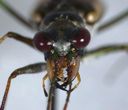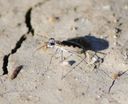Saline Tiger Beetles
Eunota
Classification
- Phylum: Arthropoda
- Subphylum: Hexapoda
- Class: Insecta
- Order: Coleoptera
- Suborder: Adephaga
- Family: Carabidae
- Subfamily: Cicindelinae
- Tribe: Cicindelini
- Genus: Eunota
Pronunciation
How to pronounce Eunota: //juːˈnoʊtə//
These audio files are automatically generated. While they are not always 100% accurate, they are a good starting point.
Images






Summary
Eunota is a genus of saline tiger beetles characterized by their predatory nature and unique adaptations to saline habitats. They are found primarily in the U.S. and Mexico and include notable species such as the California Tiger Beetle and the Cream-edged Tiger Beetle.
Physical Characteristics
Eunota species typically exhibit a distinctive, slender body shape with elongated legs. They often have bright coloration and patterns on their elytra (wing covers), which can include metallic sheen.
Identification Tips
Look for their characteristic long legs and rapid movements. Their coloration and patterns may vary by species, aiding in identification. The California Tiger Beetle, for example, has a distinct color pattern that differs from others in the genus.
Habitat
Saline habitats such as salt flats, tidal flats, and sandy areas near water bodies.
Distribution
Primarily found in the United States and Mexico.
Diet
Eunota beetles are predatory and primarily feed on other small insects and invertebrates.
Life Cycle
Eunota undergo complete metamorphosis, with life stages including egg, larva, pupa, and adult. Detailed life cycle information may vary by species.
Reproduction
Mating typically occurs on or near their habitats. Females lay eggs in burrows or sandy substrates.
Predators
Natural predators include birds and other larger insects that prey on beetles.
Ecosystem Role
As predators, Eunota species help control populations of other insects, contributing to the balance of their ecosystems.
Collecting Methods
- Sweep netting
- Pitfall traps
- Hand collecting in habitat
Preservation Methods
- Alcohol preservation
- Pinned specimens
- Frozen storage for future study
Evolution
The genus Eunota is believed to have evolved adaptations for life in saline environments, showcasing a history of specialization among tiger beetles.
Similar Taxa
Misconceptions
Some may confuse Eunota species with other similar-looking beetles, leading to misidentification. It's important to note that not all tiger beetles inhabit saline environments.
Tags
- Eunota
- Saline Tiger Beetles
- Beetles
- Cicindelidae
- Insects